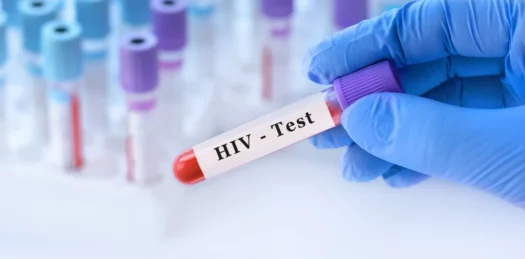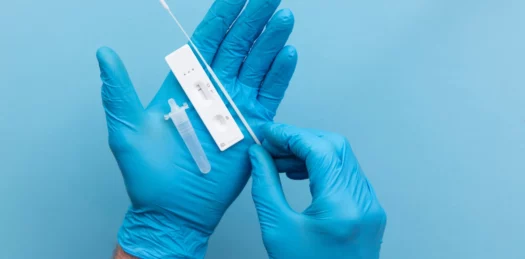As a company, we support manufacturers of in vitro diagnostic medical devices within the full scope of diagnostic areas. The experience and knowledge our experts bring to the table allow us to provide services at a professional level.
We offer reliable support for manufacturers, starting from the trial planning stage and trial feasibility analysis, through drafting documentation, obtaining trial approval, identifying and matching the appropriate site, and finally drafting a full trial report. We tailor action plans to the needs of manufacturers.
What is an in vitro diagnostic medical device?
An in vitro diagnostic medical device is a device intended for testing samples obtained from a human body in order to provide diagnostic information and for monitoring purposes. In vitro diagnostic medical devices include reagents, calibrators, control materials, kits, instruments, apparatus, equipment, sample containers and software – to be used alone or in combination. These products may be used for diagnostics, support of diagnostics, screening, monitoring, identification of predispositions, prognosis, prediction or determination of physiological condition.
What is in vitro device performance evaluation?
The device performance evaluation means both the trial and the data analysis performed in order to determine the scientific importance, as well as analytical and clinical performance. The key motivation behind the development of a new diagnostic device is to demonstrate correct results correlating with a particular clinical condition of a patient. Clinical performance evaluation of a diagnostic device is meant to confirm product efficacy.
01
Statistical analysis
Each clinical trial should be planned in accordance with recognized standards and legal regulations. This plan should include the purpose of the trial, endpoints, data capture methodology, inclusion and exclusion criteria, sample size with scientific justification, data processing method, statistical methods and assumptions.
Appropriate statistical analysis is the key element of a properly designed clinical trial. If a performance evaluation provides data that may disclose differences between the effects of two or more factors, statistical analyses are used to establish whether such differences are real or accidental. Additionally, one of the key aspects of statistical analysis is estimating the sample size.
Pure Clinical provides support for manufacturers throughout the entire in vitro diagnostics medical device performance evaluation process. Based on an appropriate statistical analysis, we are able to plan a reliable trial and summarize its results.
Q&A:
What is blinding?
Blinding in clinical trials is used in order to remove all bias and assumptions that may appear intentionally or unintentionally, if subjects or investigating team are aware of the expected result. A blinded trial is the opposite of an open label trial, in which all the parties are aware of the trial aspects.
What is diagnostic sensitivity?
Diagnostic sensitivity is defined as the percentage of true positives among all positive results. It means the ability of an in vitro diagnostic medical device to provide a positive result in a patient. This parameter is defined as the ratio of true positives and the total of true positives and false negatives.
What is diagnostic specificity?
Diagnostic specificity is the percentage of true negatives in all negative results. This parameter is defined as the ratio of true negatives and the total of true negatives and false negatives.
What is confusion matrix?
This is the so-called error table/matrix with two rows and two columns, which provides the number of true positives, false negatives, false positives and true negatives. The matrix allows an accurate analysis and visualization of quality test results.
02
Safety
AE stands for an adverse event. This constitutes any untoward medical occurrence in a trial subject. Adverse events can be mild, moderate or severe and may be caused by other factors than the treatment used. In diagnostic device performance evaluation, an adverse event can also involve inappropriate patient management decisions, as well as unintentional disease, injury or adverse clinical signs in trial subjects.
An adverse device effect is a similar term used in performance evaluation of in vitro diagnostics medical devices, referring to an event related to the use of a diagnostic medical device, resulting from misuse or intended improper use.
Q&A:
What is SAE?
SAE stands for a serious adverse event. This adverse event can lead to death or serious deterioration in the health of the subject.
03
Medical records
Medical records require authors to have a good grasp of medical terminology and knowledge of terms related to the diagnostic or therapeutic area, as well as being familiar with documentation structure. Drafting medical reports includes preparation of scientific documents, including those related to trials already completed or regulatory documents.
Pure Clinical offers a range of experts with many years of medical industry experience in writing, editing and evaluation of medical records. We are also familiar with the structure of regulatory documents and technical documentation templates for medical devices and in vitro diagnostic medical devices. We are able to walk the manufacturer through the entire trial process, creating the highest quality medical records.
Q&A:
How to draft a Clinical Performance Study Report (CPSR)?
The in vitro diagnostic device performance evaluation report is one of the most important documents representing the device’s efficacy. The CPSR should describe the design, conduct, statistical analysis and results of the clinical efficacy trial. A correctly drafted report should incorporate the appropriate legal regulations and include terminology related to the intended diagnostic area. A strictly specified structure of the document facilitates review and understanding.
Trial plan?
Correct preparation of a clinical efficacy trial plan requires in-depth knowledge of the in vitro diagnostic medical device and legal regulations that should be followed while designing the performance evaluation.The key is to specify the document audience. The author of the performance evaluation plan must consider the audience’s level of expertise. If the plan is addressed to investigators familiar with the terminology and vocabulary typical for a given discipline, the plan should be drafted using industry-specific terms and detailed technical information. A performance evaluation plan addressed to subjects or non-professional users of a diagnostic medical device should take int consideration the audience’s expertise and their capabilities in terms of comprehension of the document. Transparency and legibility of the document are also crucial.
What should be included in the performance evaluation plan?
The trial plan is an important document specifying the rationale, objectives, methodology, risks, proposed result analysis, monitoring and record-keeping related to the clinical efficacy trial. Requirements regarding the site, investigator, and subject inclusion and exclusion criteria should also be defined in a performance evaluation plan.
What is a CRO?
CRO (contract research organization) is a company offering support for the pharmaceutical or medical devices industry in the form of contracted services. Some of the services provided by a CRO include: drafting performance evaluation trial plans, feasibility checks, drafting documentation, clinical trial management or conducting of performance evaluation, as well as monitoring. Lowering the costs related to the trial conduct and market entry facilitation are the aim of any cooperation with a CRO.
04
Trial monitoring
Monitoring constitutes a key element of quality assurance, helping to ensure transparency and reliability of data obtained in clinical trials. In accordance with Good Clinical Practice principles described by ICH-GCP, constant monitoring is recommended before, during and after clinical performance evaluation.
A clinical trial should be conducted based on the previously drafted trial protocol, and any data obtained must be thoroughly documented. Moreover, trial data must be analysed and reported according to the trial design. What is particularly important is for the ethical aspects of the trial to be in line with the applicable legal provisions. Trial monitoring covers the scope of planned, systematic activities that are to ensure transparency in conducting clinical trials, data reliability and protection of the subjects’ rights.
The Pure Clinical team is composed of experts in various fields. We provide monitoring support for a wide range of diagnostic trials. We have the skills and structures necessary to cooperate with trial sites in a seamless and effective manner.
Q&A:
What is monitoring?
Performance evaluation monitoring is a set of systematic activities that are to provide trial progress oversight and ensure that it is conducted, recorded and reported in accordance with the plan and procedures established.
What is point of enrolment?
Point of enrolment is the moment when, after being recruited, the subject signs and dates an informed consent form or otherwise starts their participation in the trial.
What is informed consent?
Informed consent is a process by which a subject voluntarily confirms their willingness to participate in a particular performance evaluation, after having been duly informed of all aspects of the trial that are relevant to the decision to participate.
What is the Declaration of Helsinki?
The Declaration of Helsinki is a document of the World Medical Association which was first drafted in 1964. It defines principles for medical research involving human subjects.
What is GCP?
GCP stands for Good Clinical Practice. It is an international set of rules determining the principles for designing, performing and recording results of clinical research on human subjects. Good Clinical Practice was compiled by the International Conference on Harmonization of Good Clinical Practice (ICH-GCP).
05
Trial design and approval
The performance evaluation plan involves identification of a set of tests and experiments on human subjects or with the use of biological material. Presenting reliable data regarding the efficacy of an in vitro diagnostic medical device constitutes the primary goal of the trial. When designing a trial, current regulatory requirements, ethical issues and a statistical analysis should be taken into consideration. A correct design of a trial facilitates its conduct by the investigational team.
Knowledge of legal regulations applicable for a given region allows to seamlessly complete the registration procedures, submit a trial to the Ethics Committee and obtain trial approval from relevant state authorities.
Q&A:
What legal requirements must be met in order to start a performance evaluation for a new diagnostic medical device?
A performance evaluation of a diagnostic medical device may be started after the manufacturer drafts the appropriate documentation and completes the device design stage. When the trial site location is established, all legal regulations related to starting a trial at the national level should be considered. It also needs to be established whether an application to the Ethics Committee is required.
How long does it take to obtain trial approval?
The time needed to obtain approval for conducting a performance evaluation depends on the trial type and trial site location. The approval process depends on dates of meetings of local Ethics Committees and deadlines of local state authorities.
What is an interventional clinical performance study?
In an interventional clinical performance study, test results obtained during the trial may influence patient treatment decisions and may be used to guide treatment.
What is risk assessment?
In a performance evaluation, “risk” means the combination of the probability of occurrence of harm and the severity of such harm. A risk analysis involves systematic use of available information to identify and estimate risks. Such activities include examination of various sequences of events which may cause dangerous situations and damage.
A risk analysis of an in vitro diagnostics device should result in defining all anticipated serious adverse device effects.
What is clinical performance study?
A clinical performance study is a clinical performance evaluation of a medical device. Its objective is to determine or confirm clinical performance of a device.
06
Reporting
Clinical Performance Evaluation Report is one of the most important documents related to a medical device. It is a scientific document that includes detailed information on the methods applied and trial results. The performance evaluation report proves the efficacy and safety of a medical device.
It includes key parameters of a device and results obtained by target users. The quality of the report should reflect the high standard of the trial completed. Following Good Clinical Practice principles, ISO 145155 and ISO 20916, a comprehensive document should be drafted, presenting the project assumptions, subject inclusion and exclusion criteria, statistical analysis and results.
With support from Pure Clinical, trial reports are complete and consistent documents in line with the applicable guidelines. We focus on the highest quality of our documentation.
Q&A:
What is CPSR?
CPSR stands for Clinical Performance Study Report. This is a document containing a report on the performance evaluation and all appendices. This document summarizes all assumptions, course, statistical analysis, as well as a summary of performance evaluation.
What is an endpoint?
Endpoints of the performance evaluation are important events significant for the trial subject or tested material. The index used in clinical efficacy trials completed as part of performance evaluation of a medical device for IVD may be an example of an endpoint with regards to the in vitro diagnostic medical device.
What does EC mean?
EC stands for Ethics Committee. This is an independent institution whose task is to review and verify the trial design in order to protect the rights, safety and well-being of subjects participating in the trial.
07
Data management
A clinical trial management system is a kind of a system or software developed for clinical trial projects management. It enables planning, reporting and tracking all trial aspects. The aim of using an implemented data management system is efficient and proper trial performance at one or several sites.
Using a transparent clinical data management system allows to earn the trust of supervisory institutions and regulatory agencies. We earned trust by ensuring proper consistency in collecting, integrating and verifying clinical trial data. A tried and tested strategy for efficient data management system implementation helps reduce the risk and execution time.
Q&A:
What guarantees trial credibility?
A quality management system guarantees the credibility of the performed trials. A high-quality trial allows drafting correct and consistent documents. ISO 15189 is the standard that governs the quality system and technical competences for medical laboratories. This is a standard specifying the organizational structures of the laboratory, as well as division of responsibilities and determining rules for information transfer. ISO 15189 draws particular attention to the quality of methods and trial equipment.
What guarantees trial credibility?
A quality management system guarantees the credibility of the performed trials. A high-quality trial allows drafting correct and consistent documents. ISO 15189 is the standard that governs the quality system and technical competences for medical laboratories. This is a standard specifying the organizational structures of the laboratory, as well as division of responsibilities and determining rules for information transfer. ISO 15189 draws particular attention to the quality of methods and trial equipment.
What is accreditation?
Accreditation is a formal acknowledgement of the laboratory’s authorization to issue certificates and decisions in accordance with specified standards and to perform duties in accordance with the scope of activity. Accreditations are issued by government entities based on precisely defined procedures. Test results delivered by an accredited laboratory are reliable, resulting in greater social trust, driven by the standards met.
What is ISO 15189?
ISO 15189:2012 specifies the quality and competence requirements for medical laboratories. This standard may be used by medical laboratories to develop quality management systems and estimate their own capacity.
What is ISO 20916?
The ISO 20916 standard defines good trial practice for the planning, performance, recording and reporting of clinical performance trials carried out to evaluate performance of in vitro diagnostic medical devices. The main purpose of ISO 20916 is to ensure that the trials performed lead to reliable and consistent results. This document also specifies the responsibilities of the sponsor and investigator.
08
Trial feasibility
Determination of the so-called trial feasibility is one of the first steps in the performance evaluation of a diagnostic medical device. This process includes the assessment of environmental potential in a given geographical location and whether the trial fits in with the following: guidelines included in the protocol, the analyte used, subject types and the potential for conducting the trial in a given country. Thorough trial feasibility verification allows for a realistic assessment, as well as for the efficient commencement and conduct of a clinical trial.
Trial feasibility can be assessed at many levels. The primary trial feasibility check includes analysis of the trial protocol. Proper selection of a trial site stems from a properly performed site analysis. A review of the data regarding trial subject recruitment and demographic estimations at the local level is also important.
Feasibility analysis at the epidemiological level allows to determine the incidence rate of a certain condition in a given geographical region, as well as to conduct data analysis and verify ethical issues. The key element at the trial commencement stage is also checking trial feasibility at the legislative level, which requires the knowledge of applicable legal regulations in a given region.
By cooperating with Pure Clinical, IVD manufacturers can efficiently confirm trial feasibility, adjust the protocol to local conditions and save time spent on preparations. The advantage we offer is prompt action and familiarity with local conditions.
Q&A:
What factors impact trial feasibility?
Trial feasibility is influenced by external factors, such as epidemiological situation or availability of samples. Trial feasibility also depends on the specific aspects of a site where testing is planned to be performed.How to confirm trial feasibility?The trial feasibility check is a multi-faceted topic and requires an analysis of epidemiological aspects, verification of trial sites capabilities and the stage of preparations of the in vitro diagnostic device manufacturer for trial commencement.
Trial feasibility should be investigated in many aspects through the analysis of generally available data, conducting and verifying surveys, discussions with professionals in a given discipline or taking into consideration the existing expertise.
What factors impact trial feasibility?
Trial feasibility is influenced by external factors, such as epidemiological situation or availability of samples. Trial feasibility also depends on the specific aspects of a site where testing is planned to be performed.
How to find the appropriate trial site?
When searching for a trial site, it is crucial to define the primary assumptions for the trial. The planned trial population, equipment and quality assurance system should be taken into consideration. Access to an appropriate number of samples is the key aspect when searching for a site.
Population size in a given region
The basic trial planning element in a given country is checking the number of cases registered in the region that could be included in the trial. The number of positive samples impacts the future trial conduct pace and the statistical analysis.




